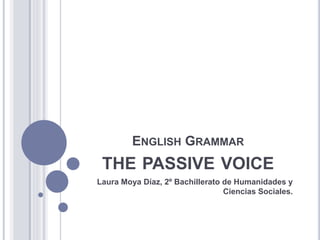
ENGLISH THE PASSIVE VOICE
- 1. ENGLISH GRAMMAR THE PASSIVE VOICE Laura Moya Díaz, 2º Bachillerato de Humanidades y Ciencias Sociales.
- 2. ÍNDICE 1. USOS 2. FORMA DEL VERBO PASIVO 3. PASAR UNA FRASE ACTIVA A PASIVA 4. EJEMPLOS
- 3. 1. USOS 3. El español la considera una construcción formal, siendo común encontrarla en medios escritos. Por ello, a veces, no nos suena tan natural. Una manzana es comida por mí An apple is bitten by me 2. La pasiva se forma exactamente igual que en español, pero su uso es mucho más frecuente en inglés. Yo como una manzana I eat an apple 1. Destacar la acción, siendo más importante que el sujeto. Por ser poco relevante Porque no se quiere nombrar o no se conoce
- 4. 2. FORMA DEL VERBO PASIVO
- 5. EJEMPLOS CON EL VERBO SEND (ENVIAR) ACTIVA - PASIVA PRESENT SIMPLE Paul sends the letter online – The letter is sent online by Paul PAST SIMPLE Paul sent the letter online – The letter was sent online by Paul PRESENT PERFECT SIMPLE Paul has sent the letter online – The letter has been sent online by Paul PAST PERFECT SIMPLE Paul had sent the letter online – The letter had been sent online by Paul PAST PARTICIPLE SENT PAST S. SENT BASE FORM SEND
- 6. FUTURE Paul will send the letter online – The letter will be sent online by Paul GOING TO Paul is going to send the letter online – The letter is going to be sent by Paul MODAL VERB Paul should send the letter online – The letter should be sent online by Paul Paul must send the letter online – The letter must be sent online by Paul Paul can send the letter online – The letter can be sent online by Paul
- 7. 3. DE ACTIVA A PASIVA El objeto directo de la voz activa pasa a ser el sujeto de la pasiva. El sujeto de la pasiva se convertirá en el complemento agente que realiza la acción. La acción está hecha por/by.
- 8. Se pone como sujeto el primer complemento que haya detrás del verbo en activa, ya sea directo o indirecto. Se pone el verbo to be en el mismo tiempo en el que se encontraba el verbo principal de la voz activa, y el verbo principal se pone en participio. Los verbos modales y be going to no cambian, pues es el verbo quien los acompaña en pasiva. El sujeto va precedido por by. He will give him a computer >> He will be given a computer
- 9. 4. EJEMPLOS VOZ ACTIVA – VOZ PASIVA He writes a book – A book is written The technician has fixed the computer – The computer has been fixed by the technician The teacher can use tutorials – Tutorials can be used by the teacher Somebody bought my picture – My picture was bought by somebody Paul gives me a book – I am given a book
